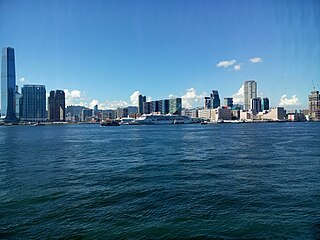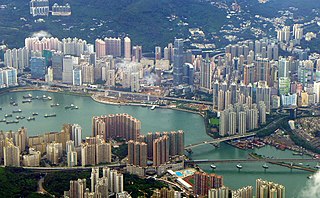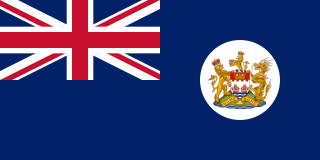
Hong Kong Island is an island in the southern part of Hong Kong. The island, known originally and on road signs simply as "Hong Kong", had a population of 1,289,500 and a population density of 16,390 per square kilometre (42,400/sq mi), as of 2008. The island had a population of about 3,000 inhabitants scattered in a dozen fishing villages when it was occupied by the United Kingdom in the First Opium War (1839–1842). In 1842, the island was formally ceded in perpetuity to the UK under the Treaty of Nanking and the City of Victoria was then established on the island by the British Force in honour of Queen Victoria. The Central area on the island is the historical, political and economic centre of Hong Kong. The northern coast of the island forms the southern shore of the Victoria Harbour, which is largely responsible for the development of Hong Kong due to its deep waters favoured by large trade ships.

Kowloon is an urban area in Hong Kong comprising the Kowloon Peninsula and New Kowloon. It has a population of 2,019,533 and a population density of 43,033/km2 (111,450/sq mi) in 2006. It is one of the three regions of Hong Kong, along with Hong Kong Island and the New Territories, and is the smallest, second most populous and most densely populated.

Tsuen Wan District is one of the 18 districts of Hong Kong. It is located in the New Territories and is served by the Tsuen Wan line of the MTR metro system. Its area is 60.7 km2. Its residents, who mostly live in Tsuen Wan Town, enjoy the highest income in the New Territories.

Henry Tang Ying-yen is a Hong Kong politician who served as the Chief Secretary of Hong Kong between 2007 and 2011. He held the position of Financial Secretary from 2003 to 2007. In 2012, he lost the Hong Kong Chief Executive Election to Leung Chun-ying.

Wong Tai Sin Temple is a well known shrine and tourist attraction in Hong Kong. It is dedicated to Wong Tai Sin, or the Great Immortal Wong. The 18,000 m2 (190,000 sq ft) Taoist temple is famed for the many prayers answered: "What you request is what you get" (有求必應) via a practice called kau chim. The temple is located on the southern side of Lion Rock in the north of Kowloon.

North Point is a mixed-use urban area in the Eastern District of Hong Kong. Located in the northeastern part of Hong Kong Island, the area is named after a cape between Causeway Bay and Tsat Tsz Mui that projects towards Kowloon Bay.

The Battle of Hong Kong, also known as the Defence of Hong Kong and the Fall of Hong Kong, was one of the first battles of the Pacific War in World War II. On the same morning as the attack on Pearl Harbor, forces of the Empire of Japan attacked the British Crown colony of Hong Kong around the same time that Japan declared war on Great Britain. The Hong Kong garrison consisted of British, Indian and Canadian units, also the Auxiliary Defence Units and Hong Kong Volunteer Defence Corps (HKVDC).

British Forces Overseas Hong Kong comprised the elements of the British Army, Royal Navy and Royal Air Force stationed in British Hong Kong. The Governor of Hong Kong also assumed the position of the commander-in-chief of the forces and the Commander British Forces in Hong Kong took charge of the daily deployment of the troops. Much of the British military left prior to the handover of Hong Kong to China in 1997. The present article focuses mainly on the British garrison in Hong Kong in the post Second World War era. For more information concerning the British garrison during the Second World War and earlier, see the Battle of Hong Kong.

The Imperial Japanese occupation of Hong Kong began when the governor of Hong Kong, Sir Mark Young, surrendered the British Crown colony of Hong Kong to the Empire of Japan on 25 December 1941. His surrender occurred after 18 days of fierce fighting against the Japanese forces that invaded the territory. The occupation lasted for three years and eight months until Japan surrendered at the end of the Second World War. The length of the period later became a metonym of the occupation.

Lai Chi Kok Road is a road in western Kowloon, Hong Kong. It links Lai Chi Kok to Mong Kok, via Tai Kok Tsui, Sham Shui Po and Cheung Sha Wan. It starts from a junction with Nathan Road near Pioneer Centre in the south and ends near Mei Foo Sun Chuen. The road is bidirectional except the section at Lai Chi Kok, between the junction with Butterfly Valley Road and Mei Foo Sun Chuen, where it serves New Territories-bound traffic only. The Kowloon-bound traffic uses Cheung Sha Wan Road, separated by the flyover of Kwai Chung Road. The road once hosted shipyards, fish, meat and vegetable wholesale markets, which were moved closer to the coast after extensive reclamation.

Sham Shui Po Park is a park in Sham Shui Po, New Kowloon, Hong Kong. It comprises two physically discontiguous sites on either side of Lai Chi Kok Road. The larger site is more well-known as Sham Shui Po Park. The smaller, located within Lai Kok Estate and originally managed by the Housing Authority, became part of Sham Shui Po Park when it was transferred to the Leisure and Cultural Services Department.

Sai Wan War Cemetery is a military cemetery located in Chai Wan, Hong Kong which was built in 1946. The cemetery was created to commemorate soldiers of Hong Kong Garrison who perished during the Second World War. The cemetery also contains 12 World War I burials. A total of 1,528 soldiers, mainly from the Commonwealth, are commemorated here. Most of the remaining burials are located at the Stanley Military Cemetery.

Royal Tramp II is a 1992 Hong Kong film based on Louis Cha's novel The Deer and the Cauldron. The film is a sequel to Royal Tramp, which was released earlier in the same year.
Articles related to Hong Kong include:
The 2009–10 Hong Kong Football Association First Division League was the 98th top tier football league of Hong Kong. Because of the renovation of Mong Kok Stadium which will last for two league seasons, the current First Division League has allocated eight stadia for the eleven participating teams to play their home games.

The Duke of Mount Deer is a Hong Kong television series adapted from Louis Cha's novel The Deer and the Cauldron. It was first aired on TVB in Hong Kong in 1998.

William Sui-tak Louey was a Hong Kong businessman and the founder and Chief Manager of the Kowloon Motor Bus Company.

Lam Cho was the Hung Ga Grandmaster and Dit Da practitioner of the Lam Family Hung Ga lineage. He was noted to be the last martial arts Grandmaster who lived during the times of well-known martial artists Wong Fei-hung and Lam Sai-wing, his adoptive uncle.

The East River Column or Dongjiang Column was a unit of anti-Japanese Communist guerrillas that operated in Guangdong and Hong Kong during the Second Sino-Japanese War. They played a major role in Chinese resistance against Japanese occupation, and remain an important part of local historical traditions about the war and the subsequent Communist Revolution. They are also notable outside of China for being the only Chinese Communist unit transported on US Navy vessels, done as part of the peace negotiations led by the Marshall Mission.
















